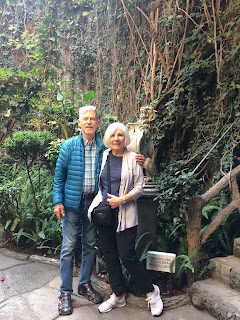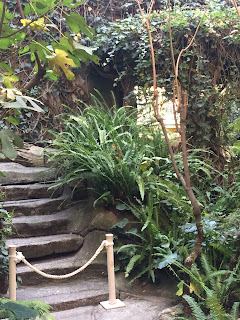Observances about nature and life from just outside Victoria BC . . . and from sundry other locations
Monday, December 30, 2019
Ancient Zapotec ruins
I’m having trouble getting more than a few photos onto my blog posts. So here are the images for Mitla and Monte Alban.
Zapotec weaving and ancient ruins
Oaxaca is at the centre of many villages with centuries-long craft traditions, most notably weaving and pottery. We went to a family weaving cooperative to see the process of making the traditional rugs of the area. It involves carding and dying the wool with natural dyes and then spinning by hand. It’s a lengthy process and it results in an incredible range of gorgeous colours.
The wool is then woven on looms of different sizes to create scarves, bags, shawls, and rugs of different sizes. This is the largest loom, which creates rugs as wide as eight feet.
This is Laine with her daughter Calla showing the rug they chose.
On the same trip we stopped at Mitla to see the Zapotec ruins of a ceremonial centre. This place was built in the 12th C and has decorated walls made from patterns of carved stones.
The archeological finds in this area go back to thousands of years. We passed one site called Yagul, which was occupied 10,000 tears ago. We also visited Monte Alban, a huge city that dates from 800 BC. Monte Alban’s Tomb 7 was discovered in the 1930s and yielded gold, crystal and turquoise artifacts plus pearls and carvings and jewelry. It’s on display in the museum of Oaxaca culture housed in an ex-convent with beautiful vistas of the area.
The people of this area are proud of their cultural heritage and traditional crafts are still made today. We went to the Sunday tiangui, or traditional market at the village of Tlacolula where I bought a coral world d carving of an imaginary animal. The area is famous for these carvings, known as Alebrijes. The market sold everything you could ever want, from hammocks to hand lotion. And it seems that some villagers here are descended from people who lived in Yagul thousands of years ago.
We only scratched the surface of the rich history of this fascinating area. We are hoping to come back again and stay longer.
The wool is then woven on looms of different sizes to create scarves, bags, shawls, and rugs of different sizes. This is the largest loom, which creates rugs as wide as eight feet.
This is Laine with her daughter Calla showing the rug they chose.
On the same trip we stopped at Mitla to see the Zapotec ruins of a ceremonial centre. This place was built in the 12th C and has decorated walls made from patterns of carved stones.
The archeological finds in this area go back to thousands of years. We passed one site called Yagul, which was occupied 10,000 tears ago. We also visited Monte Alban, a huge city that dates from 800 BC. Monte Alban’s Tomb 7 was discovered in the 1930s and yielded gold, crystal and turquoise artifacts plus pearls and carvings and jewelry. It’s on display in the museum of Oaxaca culture housed in an ex-convent with beautiful vistas of the area.
The people of this area are proud of their cultural heritage and traditional crafts are still made today. We went to the Sunday tiangui, or traditional market at the village of Tlacolula where I bought a coral world d carving of an imaginary animal. The area is famous for these carvings, known as Alebrijes. The market sold everything you could ever want, from hammocks to hand lotion. And it seems that some villagers here are descended from people who lived in Yagul thousands of years ago.
We only scratched the surface of the rich history of this fascinating area. We are hoping to come back again and stay longer.
Saturday, December 28, 2019
Oaxaca glimpses
Oaxaca is a beautiful, gentle city with a gorgeous Centro featuring world-class restaurants side by side with humble eateries, dozens of craft shops and art galleries, and an edgy sense of design. We spent five days there and barely scratched the surface.
Wednesday, December 25, 2019
Christmas in Oaxaca
One of the reasons we chose to come to Oaxaca at Christmas is the unique festivals that take place in this small city in the mountains of southwest Mexico. Most notably the annual Noche de Rabanos, orNight of the Radishes on December 23rd. This is a radish carving contest that’s been happening for more than 120 years. Artisans create dioramas out of giant radishes and everyone in town goes down to see them in the zocalo. This year there are over 100 entries on display and people line up for hours to cruise along an elevated walkway past the displays. Here’s a photo of this year’s winner—a giant octopus.
Eventually they all converged at the zocalo where some bands set up with marimbas, others with trumpets and other brass instruments. Families wandered around with balloons and sparklers, some visiting the multiple Santas in sleighs to get their photos taken. Others heading up the stairs to the bandstand decorated with lights. We stat at a table under the portales eating tortes and drinking margaritas. The various dancers and puppets and papier-mâché lanterns paraded around the edge. It was a wonderful celebration.
The following night was Christmas Eve and again we headed down to the zocalo. This time for the Christmas celebrations. Featuring floats, dancers and musicians from each of the different parishes in the city.
Thursday, December 19, 2019
Here’s why we like Mexico City

Here we are again in Mexico City. It’s one of our favourite places to visit for a few good reasons:
Firstly, it’s now familiar to us as we’ve been here several times in recent years and we know a good, reasonable place to stay in Roma Norte.
Actually this time we got the best room of this old home converted to a Bed and Breakfast. We’re
in the former dining room complete with chandelier and stained glass windows.
Secondly, it’s so easy to get around using the Metro and the Metro Bus. The Metro was our go-to transit method until this trip. There are currently 12 lines, most of them underground that quickly and easily get you around—just as long as you between 10 am and 3 pm when it’s less crowded. But this time we’re using the Metro Bus. These bright red articulated buses run on dedicated bus lanes. Line 1 opened in 2016 and there are now seven lines. The cost is about 50 cents and you can tap in with a card. So easy. And fun to bypass lanes of stalled cars in the bus lane.
Thirdly, there’s the food. From street tacos (choose your vendor from those where people are lining up) to elegant high end restaurants with finger bowls, to trendy eateries, it’s all here. Mexicans love seafood and it’s trucked in fresh each day. Yesterday I had a sizzling pan full of prawns, lobster, crab, mussels and fish in a delicious saffron sauce. The cost worked out to about 15 dollars, less than you can pay for a hamburger at home. The photo above is our lunch yesterday in a very trendy Roma restaurant. Equally a bargain.
That leads me to the fourth reason: It a bargain. From food to taxis to accommodation, everything seems very reasonable by Canadian standards.
And of course, the fifth and biggest reason is the immense number of things to see and do. There are over 100 museums in the city, many of them free of charge. Mexico excels with design and flair. A mix of upscale and indigenous crafts makes everything interesting. Plus there’s a strong hipster vibe in the neighbourhoods we’ve been visiting.
More pics from the free museum
Harry and I posing at the bottom of some very uneven stairs. This museum was full of ancient paintings and sacred sculptures collected by the owner.
Yesterday we went to the Casa Guillermo Tovar de Teresa, an old home just around the corner of where we’re staying a beautiful private garden and art pieces and living spaces. The previous owner passed away at an advanced age and the Casa was purchased by Carlos Slim and in now part of the Museo Soumayo.
I’m trying blogging on my iPad and having some difficulty. Can’t really format it the way I’d like to. So I’ll add just a few more photos and call it a day.
Sunday, December 8, 2019
Collage explorations
I went to a one-day collage course today at the Vancouver Island School of Art. It was a super fun and kind of a revelation of different ways to move with my painting. I now see there are lots of ways to add texture and subtlety to my painting.

The instructor Tony Bounsall did a great job of introducing many different approaches and techniques. All materials were provided and we used acrylic paints plus india ink plus gesso plus acrylic mediums plus tissue papers and deli papers to create the finished product. To start he had us choose a letter and create two simple designs. I chose "A" and "e" and Im quite pleased with what emerged. These are on 11x14 inch hardboard.

If it weren't for the fact that I just packed away my studio for our trip to Mexico I would be setting up to do an entire series of letters. As it is though, I'll have to put it on hold until we return in early January.
Subscribe to:
Comments (Atom)


































